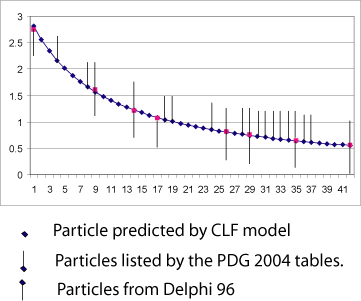Particle jets interpretation
In an article titled 'Four jet event shapes in electron-positron annihilation' J.M. Campbell, M.A. Cullen and E.W.N. Glover1 summed up as follows:
Taking together the size of the NLO corrections, the renormalisation scale dependence and poor agreement with data it appears that the inclusion of even higher order corrections and/or power corrections will be necessary to extract any useful information from these observations.
The CLF model offers a different method of interpreting the observations that does not require any corrections. The width of each jet is measured and a constant is used to reduce the scale to that of the wavelength (diameter) table so that the observations can be matched to the wavelength table without further adjustment. (The observations will only match in one position).
Using Figure 3 from the article by Campbell et al, we produce the following graph and table:
 |
|
|||||||||||||||||||||||||||||||||||||||||||||||||||||||||||||||||||||||||||||||||||||||||||||||||||||||||||||||||||||||||||||||||||||||||||||||||||||||||||||||||||||||||||||||||||||||||||||||||||||||||||||||||||||||||||||||||||||||||||||
It will be noted that one of the jet particles has not been observed by the PDG experimenters.
The measurements of the particle widths could probably be improved by those who conducted the experiment, but, we are limited to enlarging Figure 3.
This illustrate the ability of the CLF model to provide an interpretation for Quantum theory predictions that cannot be made by Quantum theory alone.
1arXiv:hep-ph/9809429v2 17 Nov 1998
Back to Index